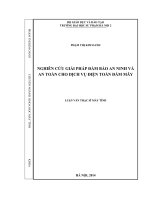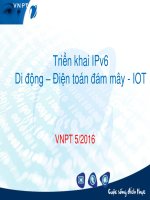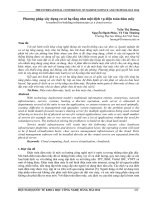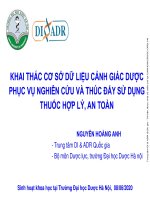bai giang khai thac dich vu dien toan dam may 5075
Bạn đang xem bản rút gọn của tài liệu. Xem và tải ngay bản đầy đủ của tài liệu tại đây (2.34 MB, 45 trang )
KHAI THÁC DỊCH VỤ
ĐIỆN TOÁN ĐÁM MÂY
Nguyen Hong Son,PhD
2
MỤC TIÊU MÔN HỌC
Cung cấp kiến thức cơ bản về nguyên lý của điện toán đám mây và làm
quen với khai thác các dịch vụ điện toán đám mây.
Kiến thức
-Phân biệt được các thành phần thiết yếu trong hệ thống hệ thống điện
tốn đám mây
-Phân biệt được các mơ hình dịch vụ điện toán đám mây gồm SaaS,
PaaS, IaaS và các xu hướng mở rộng.
Kỹ năng
-Khai thác được các nền tảng đám mây khác nhau như Amazon EC2,
Google AppEngine, Windows Azure, IBM Blumix
3
TÀI LIỆU THAM KHẢO
[1] Rajkumar Buyya, James Broberg, Andrzej M. Goscinski,
Cloud
Computing:
Principles
and
Paradigms,
Wiley
Publishing, 2011. (Lý thuyết)
[2] Các user guides từ nhà cung cấp dịch vụ đám mây như
Amazon EC2, Microsoft Azure...(Thực hành)
INTRODUCTION TO CLOUD
COMPUTING
5
Ideas
• From providing electric power to cloud computing
• Cluster computing, grid computing:
allowing access to large
amounts of computing power in a fully virtualized manner, by
aggregating resources and offering a single system view
• Main goal: delivering computing as a utility
• Utility
computing describes a business model for
on-
demand delivery of computing power; consumers pay providers
based on usage (“pay-as-you-go”).
6
What is “cloud computing”?
“Cloud is a parallel and distributed computing system consisting of a
collection of inter-connected and virtualised computers that are
dynamically provisioned and presented as one or more unified
computing resources based on service-level agreements (SLA)
established through negotiation between the service provider and
consumers.”
Buyya et al
7
What is “cloud computing”?
“Clouds are a large pool of easily usable and accessible virtualized resources (such as
hardware, development platforms and/or services). These resources can be dynamically
reconfigured to adjust to a variable load (scale), allowing also for an optimum resource
utilization. This pool of resources is typically exploited by a pay-per-use model in which
guarantees are offered by the Infrastructure Provider by means of customized Service
Level Agreements.”
Vaquero et al
“Clouds are hardware-based
services
offering
compute,
network,
and
storage
capacity where: Hardware management is highly abstracted from the buyer, buyers
incur infrastructure costs as variable OPEX, and infrastructure capacity is highly Elastic.”
McKinsey and Co
8
The NIST Definition of Cloud Computing
• NIST: National Institute of Standards and Technology (USA)
• "Cloud computing is a model for enabling ubiquitous,
convenient, on-demand network access to a shared pool of
configurable computing resources (e.g., networks, servers,
storage, applications and services) that can be rapidly
provisioned and released with minimal management effort
or service provider interaction."
9
Roots of Cloud Computing
• Technologies,
• Hardware (virtualization, multi-core chips),
• Internet technologies (Web services, service-oriented architectures, Web 2.0),
• Distributed computing (clusters, grids),
• Systems management (autonomic computing, data center automation)
10
From Mainframes to Clouds
• 1970s time-shared mainframe as utilities
• Expensive
• The advent of fast and inexpensive microprocessors, IT data
centers
moved
to
collection
commodity
servers the
mainframe era collapsed
• The advent of increasingly fast fiber-optics networks and new
technologies for enabling sharing of computing power over
great distances the potential of delivering computing services
with the speed and reliability
11
SOA, Web Services, Web 2.0, and Mashups
• Web services can glue together applications running on different messaging
product platforms, enabling information from one application to be made available
to others, and enabling internal applications to be made available over the
Internet
• In a SOA, software resources are packaged as “services,” which are well-defined,
self-contained modules that provide standard business functionality and are
independent of the state or context of other services
• In
Web
2.0,
the
consumer
Web,
information
and
services
may
be
programmatically aggregated, acting as building blocks of complex compositions,
called service mashups
Software as a Service (SaaS) domain
12
Grid Computing
• Grid
computing
enables
aggregation
of
distributed
resources and transparently access to them
• The
development
several
grid
of
standardized
computing activities
protocols
has
for
contributed,
theoretically, to allow delivery of on-demand computing
services over the Internet
13
Utility Computing
• In utility computing environments, users assign a “utility”
value to their jobs.
• Utility is a fixed or time-varying valuation that captures
various QoS constraints
• The
valuation is the amount they are willing to pay a
service provider to satisfy their demands.
14
Hardware Virtualization
15
Management of workload in a virtualized
system
Basic capabilities regarding management of workload in a
virtualized system:
• Isolation: all program instructions are fully confined inside a VM
• Consolidation:
The
consolidation
of
several
individual
and
heterogeneous workloads onto a single physical platform leads to
better system utilization.
• Migration: facilitating hardware maintenance, load balancing, and
disaster recovery.
16
VMM platforms
• VMWare ESXi: It is a bare-metal hypervisor, meaning that
it installs directly on the physical server
• Xen: has served as a base to other virtualization products,
both commercial and open-source.
• KVM (kernel-based virtual machine): a Linux virtualization
subsystem
17
Virtual Appliances
• An application combined with the environment needed to run it
(operating system, libraries, compilers, databases, application
containers, and so forth) is referred to as a “virtual appliance.”
• An appliance is shaped as a VM disk image associated with hardware
requirements, and it can be readily deployed in a hypervisor.
• The VMWare virtual appliance marketplace allows users to deploy
appliances on VMWare hypervisors or on partners public clouds
• Amazon allows developers to share specialized Amazon Machine
Images (AMI) and monetize their usage on Amazon EC2
18
Open Virtualization Format
• Each Hypervisor supports a different VM image format and the
formats are incompatible with one another
• In order to facilitate packing and distribution of software to be run on
VMs several vendors, including VMware, IBM, Citrix, Cisco, Microsoft,
Dell, and HP, have devised the Open Virtualization Format (OVF)
• An OVF package consists of a file, or set of files, describing the
VM hardware characteristics (e.g.,memory, network cards, and
disks), operating system details, startup, and shutdown actions,
the virtual disks themselves, and other metadata containing product
and licensing information
19
Autonomic Computing
• Autonomic systems
rely
on monitoring
probes
and gauges
(sensors), on an adaptation engine (autonomic manager) for
computing optimizations based on monitoring data, and on effectors
to carry out changes on the system.
• The
large data centers of cloud computing need autonomic
computing
inspire
software
technologies
automation, perform tasks such as:
management of service levels of running applications;
management of data center capacity;
proactive disaster recovery;
automation of VM provisioning
for
data
center
20
Layers and Types of Clouds
• Cloud computing services are divided into three classes:
(1) Infrastructure as a Service,
(2) Platform as a Service,
(3) Software as a Service
21
Infrastructure as a Service
• Offering virtualized resources (computation, storage, and
communication) on demand
• Amazon Web Service mainly offers IaaS. EC2 service
means offering VMs.
• OpenStack is a free and open-source software platform
for cloud computing, mostly deployed as infrastructure-asa-service (IaaS)
22
23
Platform as a Service
• Offering a high level of abstraction to make a cloud easily
programmable.
• Google AppEngine offers a scalable evironment for
developing and hosting Web applications
24
25
Software as a Service
• Applications reside on the top of the cloud stack.
• End users can access services of the layer through Web portal
• Salesforce.com offers CRM applications that reside completely on
their servers, allowing customers to customize and access application
on demand









